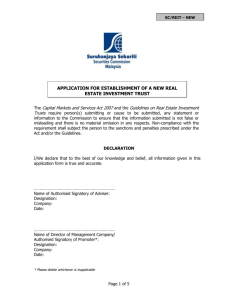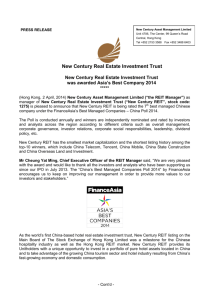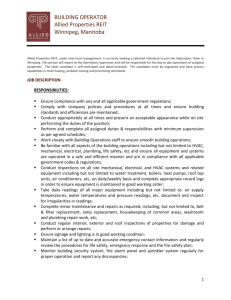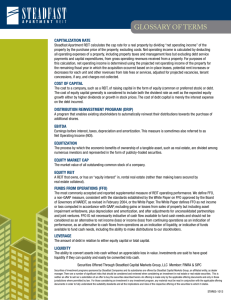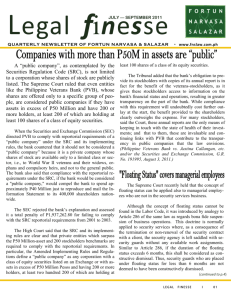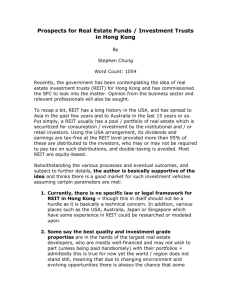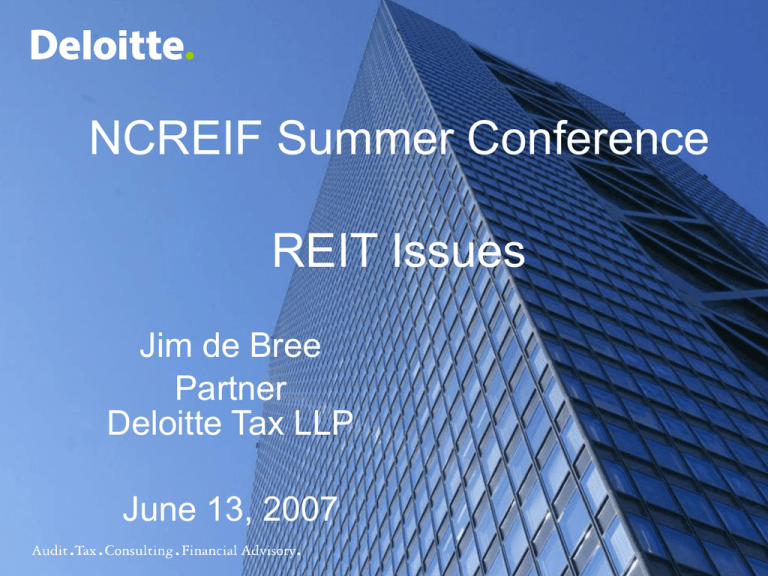
NCREIF Summer Conference
REIT Issues
Jim de Bree
Partner
Deloitte Tax LLP
June 13, 2007
REIT Status Issues/
Prohibited Transactions
Issues Affecting REIT Status
• There are a limitless number of issues that
impact REIT qualification
• Issues arising most often appear to be
– Impermissible tenant services tainting rents
– 10% securities test
– Failure to identify liability hedges and other
hedging issues
– Preferential dividends
– Goodwill and other intangible assets held by the
REIT
REIT Savings Provisions
• Asset test savings provision – section
856(c)(7)
– De minimis violations
– Other violations
• Income test savings provision – section
857(b)(5)
• Savings provision for other violations –
section 856(g)(5)
REIT Savings Provisions
• Except for de minimis asset test violations,
each of the REIT Savings Provisions
requires that the failures “are due to
reasonable cause and not due to willful
neglect.”
REIT Savings Provisions
• “Reasonable cause” in the context of obtaining a
REIT opinion
– Can a REIT get an opinion that it has reasonable cause
with respect to a particular tax position or action taken?
• Does it make a difference if the opinion is requested in advance
of taking the action or after the action has been taken by the
REIT?
– What sort of comfort level on a technical position is
needed in order to support “reasonable cause” with
respect to an action taken?
• Should there be a different standard if the REIT knows that
being wrong on the particular position will disqualify the entity?
REIT Savings Provisions
• “Reasonable cause” and the IRS
– What are the filing requirements necessary to
take advantage of the REIT Savings
Provisions?
– Is it possible to obtain a closing agreement
confirming that “reasonable cause” exists?
REIT Savings Provisions
• Possible liberalization of REIT Savings
Provisions
– IRS lacks resources to continue to pursue REIT
closing agreements
– At the urging of the IRS, consideration is being
given to eliminating the “reasonable cause”
requirement, with the offset being an increased
penalty for violations
Preferential Dividends
• Most often a problem for closely-held REITs,
including subsidiary REITs owed by public
REITs
• Consistent with its effort to reduce requests
for REIT closing agreements, the IRS is
considering administrative relief for de
minimis violations of the preferential
dividend provisions
Preferential Dividends
• Historically, there has been an issue as to whether
preferential dividends reduce current earnings and
profits under section 857(d)(1)
– If a preferential dividend reduces current earnings and
profits of a REIT, the REIT cannot pay a deficiency
dividend to cure a distribution shortfall resulting from the
preferential dividend
– A recent private letter ruling (not yet published) confirms
that section 857(d)(1) prevents the reduction of current
earnings and profits with respect to a preferential
dividend
Prohibited Transactions
• Current market factors impacting the
analysis
– Very hot market for real estate assets
• Good time to recognize appreciation
• Many unsolicited offers
– Portfolio with unwanted assets
Prohibited Transactions
• Section 857(b)(6) imposes a 100% penalty tax on
gain from dealer sales
• Legal factors in determining dealer status
– Nature and purpose of the acquisition of the property
and duration of the ownership
– Extent and nature of the REIT’s efforts to sell the
property
– Number, extent, continuity, and substantiality of the
sales
– Extent of improvement and advertising to increase
sales
– Other miscellaneous factors
Prohibited Transactions
• Safe harbor under section 857(b)(6)(C) (and (D)
for timber)
– Hold property for four years
– Limited expenditures with respect to property during 4
years prior to sale
– For a taxable year, limited to 7 sales or sales not in
excess of 10% of aggregate adjusted basis (for
earnings and profits purposes) of REIT’s assets as of
the beginning of the year
• If rely on 10% of adjusted basis rule, marketing and
development with respect to property must be
through an independent contractor from whom the
REIT does not derive income
Prohibited Transactions
• Safe harbor requirement for no more than 7
sales
– Sale of multiple properties as part of one sale is
treated as a single sale
• Safe harbor requirement relating to 10% of
adjusted basis
– Section 1031 exchange is not treated as a
“sale” for purposes of this rule (and 7 sales
rule). PLR 200701008 (no boot); PLR
200702021 (boot)
• How much boot will be tolerated?
Prohibited Transactions
• Possible liberalization of safe harbor under
RIDEA
– Reduce required holding period of property
from 4 years to 2 years
– Modify 10% of adjusted basis rule to apply with
respect to 10% of fair market value of property
held
• Special cases
– Sale of portion of portfolio or parcel acquired
– Liquidation of REIT
Prohibited Transactions
• Structures for avoiding prohibited
transactions
– Utilize TRS for sale
– Lease or debt with purchase option
– Partnership strategies with third parties
Personal Holding Companies
• In order to qualify as a REIT, 5 or fewer
persons cannot own 50% or more of stock
– If a partnership is an owner, the partners are
persons.
• In order to avoid PHC rules, 5 or fewer
persons cannot own 50% or more of stock
– If a partnership is an owner, the partnership is
a person.
Personal Holding Companies
• In order to qualify as a PHC, at least 60%
of adjusted ordinary gross income must be
PHC income
• PHC income is generally passive income,
including interest, dividends, rents,
royalties, etc.
Personal Holding Companies
• Rents are excluded from PHC income if
two requirements are met
– Rents > 50% of adjusted ordinary gross
income
– PHC pays dividends of at least 90% of PHC
income
Personal Holding Companies
• PHC is taxed on undistributed PHC
income at a 35% rate
• PHC income is income from “passive”
sources less dividends paid deduction
• Dividends paid deduction is calculated
differently for PHC purposes than for REIT
purposes 20
Personal Holding Companies
• A dividends paid deduction for liquidating
distributions cannot be claimed by a PHC
• Thus, if a REIT (that is also a PHC) is
using liquidating distributions to meet the
REIT distribution requirements, it probably
will lose its REIT status and be subject to
PHC tax.
Earnings and Profits
Earnings & Profits
• When a corporation makes a distribution
to its shareholders, that amount distributed
to the shareholders is taxable as a
dividend to the extent of earnings and
profits.
– Distributions in excess of E&P are return of
capital
• A REIT can only claim a DPD to the extent
of its earnings and profits
Earnings & Profits
• Earnings & profits is generally taxable
income adjusted for certain items
– In REIT context adjustments typically involve:
• depreciation
• basis differences resulting from depreciation
adjustments
• Installment sales adjustments
Earnings & Profits
• There are special E&P adjustments that
apply only to REITs to ensure that the
REIT has sufficient E&P to generate
dividends that qualify for the DPD
Foreign Investment
by US REITs
Foreign Investment
U.S. Tax Considerations
• Entity Classification of Investment Vehicle
– Disregarded entity or partnership
– Subsidiary REIT
– Taxable REIT Subsidiary
Foreign Investment
U.S. Tax Considerations
• Disregarded entity
– Check the box elections
– Transparent for purposes of income/asset
tests
• Subsidiary REIT
– Needs to qualify on it’s own
Foreign Investment
U.S. Tax Considerations
• Taxable REIT subsidiary
– TRS election
– 20% asset test considerations
– Sub-part F income and other inclusions
Foreign Investment
U.S. Tax Considerations
• Foreign exchange issues
– Until recently it was uncertain whether foreign
exchange gains represented qualifying
income for 95% gross income tests
– IRS recently issued two pronouncements
• Rev Rul 2007-33—foreign exchange gain qualifies
as long as underlying transaction qualifies
• IRS Notice 2007-42—guidance issued on foreign
exchange gain on repatriated amounts qualify
Foreign Investment
U.S. Tax Considerations
• Operational Issues
•
•
•
•
•
•
•
•
Cost allocations
Financing and capital structure
Management structure
Treaty benefits
REIT test monitoring
Local country tax issues
VAT recovery
Cash repatriation/withholding
Generic investment in EU
•EU Special Purpose Vehicle
•EU SPV subject to tax but deduction for
interest and depreciation lowers effective tax
rate
•Lux Hold Co (could be Netherlands)
•Small tax charge on interest spread if debt
financed
•Advance tax agreement required
•Distributions
•Withholding tax on dividend from EU SPV to
Lux Hold Co usually reduced under a treaty
or EU Parent-Sub Directive
•Potential dividend withholding tax from Lux
Hold Co. (0%-20% depending on treaty
access of investor), avoidable with debt
instruments or cash settled warrants
US
FUND
E.g. Debt or
CSW
Lux Hold Co
Bank
Debt
EU SPV
Generic investment in EU
Exit possibilities (Continued)
•Sale of asset
•Local capital gains tax at EU SPV;
•possible transfer tax but may be mitigated
•Sale of SPV shares
•local capital gains tax is deferred;
•generally no capital gains tax at Lux Hold
Co level
US
FUND
E.g. Debt or
CSW
Lux Hold Co
US Tax considerations
•Generally “check the box” flowthrough
treatment
•Need to consider impact on US REIT tests
•No foreign tax credit
•If box not checked for US purposes may be an
issue with Subpart F income.
Bank
Debt
EU SPV
Foreign Investment
in US REITs
FIRPTA
• Most foreign investors want to avoid
FIRPTA
• Domestically controlled REIT is not a US
real property interest
• Sale of REIT shares in domestically
controlled REIT is not subject to FIRPTA
• Distributions from REIT to foreign
shareholder are generally subject to
normal withholding rules.
FIRPTA
• Gain on sale of asset by REIT results in
capital gain dividend that is generally
subject to FIRPTA withholding
• To maximize flexibility, a separate REIT is
frequently created for each asset
– Buyer typically liquidates REIT after purchase
– Buyer needs to be widely held
FIN 48
Uncertain Tax Accounting for
Uncertain Tax Positions?
FIN 48
• Applies only to income taxes and taxes
measured by income
• Adopts a benefit approach rather than
liability approach
– FAS 5 deals with whether it is probable that a
liability will be asserted
– FIN 48 assumes that the liability exists and
allows the company to record an offsetting
benefit
FIN 48
• Two step process
– Identify issue (unit of account)
– Measurement of benefit
• If it is <MLTN that taxpayer will prevail, no
benefit is recorded
• If it is at least MLTN, probabilities are
assigned to each possible outcome.
– When cumulative probability > 50% that
amount of benefit is recorded
Cumulative Effect Adjustments
• Generally effective for 2007
• Determine difference between FAS 5
liability and FIN 48 liability as of 1/1/2007
• Difference is a cumulative effect
adjustment that is a charge or credit to
retained earnings
– Many REITs have distributed all of their
earnings, so the cumulative effect adjusts paid
in capital.
FIN 48 Cumulative ImpactsIllustrative
•
•
•
•
•
•
•
•
•
•
•
•
•
AMB Properties
AIM
Developers Diversified
Duke Realty
Equity Residential
First Industrial
General Growth Properties
KIMCO
Plum Creek
ProLogis
Simon
Taubman
Vornado
$0
$3
$0
$1.7
$0
$1.5
$145
$0
$0
$163
$0
$0
$0
REIT Cumulative Impacts
• Generally far less than non-REIT
companies of similar size
• Many REIT’s were initially in denial
• Wider range of effort to implement among
REIT’s than other industries
• How will IRS react to FIN 48 disclosures for
a company that isn’t supposed to pay
taxes?
REIT Specific Issues
REIT Qualification
• How far back do I have to look?
– What if you “know” there was a disqualification 8 years
ago and in the current year your REIT has a taxable
asset sale that would be subject to the built in gains
tax?
• Assume you are confident your REIT status was qualified in the
last three open tax years and the only issue is the BIG tax.
• What impact would this have on your planning and discussion
with management about a like kind exchange or delay in selling
the property?
• What impact would this discussion have on your FIN 48
analysis?
REIT Qualification
• How did you document your due diligence?
– TRS valuation issues
– “Bad” asset valuation issues
– Impermissible tenant services
– 10% securities test
– Reasonable cause for savings provisions
Transfer Pricing
• Assessment should always be at least
MLTN if there are transactions between the
REIT and the TRS
• Until regulations are issued, no 100% tax as
long as you use “any reasonable method”
(857(b)(7)(E))
– Does this mean any reasonable method or any
reasonable method permitted by Section 482?
– How liberally can this be defined for purposes
of measurement?
Transfer Pricing
• How did you document measurement?
– Most transfer pricing reports do not provide an
opinion
– Most internal allocations are prepared by cost
accountants and don’t necessarily use a
reasonable method under section 482
– Remember, if you can document a 50.x%
likelihood of sustaining the “as filed” position, no
FIN 48 liability should be accrued
Prohibited Transactions
• How did you document FIN 48 liability?
– Many REITs documented every transaction in open
years
– Many REITs used a template approach to documenting
compliance with the safe harbor
– Many REITs relied on facts and circumstances and
widely understood administrative practices for
measuring little or no liability
• Defining the unit of account was difficult
– Many REITs considered each property transaction as a
unit of account
– Others grouped similar fact patterns into a single unit of
account
• For example, if the REIT were exiting a market they might treat all
property sales pursuant to a plan as a single unit of account
Like Kind Exchanges
• How did you document the FIN 48 liability
associated with like kind exchanges?
– Most REIT’s used a template approach to sort
out exchanges that did not meet a safe harbor
or contained an identified risk
• How did you document that return of capital
dividends could be designated as a capital
gain dividend “after the fact?”
• Interplay with prohibited transaction tax
Pro-Forma Disallowance
• How did you document effect of a
disallowance on the dividends paid
deduction?
• What if the pro-forma disallowance
exceeded the return of capital?
– Did you accrue a tax?
– Did you assume the REIT would pay a
deficiency dividend?
• How did you document the REIT’s intent to pay a
deficiency dividend?
Joint Ventures
• How did you document that all material tax
positions were identified at the JV level?
– Did you approach domestic and foreign JV’s in
the same manner?
• How did you document REIT compliance
issues?
• How did you document that any REIT you
invested in was qualified as a REIT?
Other Issues We Dealt With
• Alternative Minimum Tax
•
•
•
•
•
•
Aggressive cost segregation studies
Section 118 positions
Disguised sales
Section 470
Foreign taxes
State taxes
The information contained in this publication is for general purposes only and is not intended, and should not be construed, as legal, accounting, or tax advice or
opinion provided by Deloitte & Touche to the reader. This material may not be applicable or suitable for, the reader’s specific circumstances of needs. Therefore, the
information should not be used as a substitute for consultation with professional accounting, tax, or other competent advisors. Please contact a local Deloitte &
Touche professional before taking any action based upon this information.
About Deloitte
Deloitte refers to one or more of Deloitte Touche Tohmatsu, a Swiss Verein, its member firms and their respective subsidiaries and affiliates.
Deloitte Touche Tohmatsu is an organization of member firms around the world devoted to excellence in providing professional services and
advice, focused on client service through a global strategy executed locally in nearly 140 countries. With access to the deep intellectual capital
of approximately 135,000 people worldwide, Deloitte delivers services in four professional areas, audit, tax, consulting and financial advisory
services, and serves more than 80 percent of the world’s largest companies, as well as large national enterprises, public institutions, locally
important clients, and successful, fast-growing global growth companies. Services are not provided by the Deloitte Touche Tohmatsu Verein
and, for regulatory and other reasons, certain member firms do not provide services in all four professional areas.
As a Swiss Verein (association), neither Deloitte Touche Tohmatsu nor any of its member firms has any liability for each other’s acts or
omissions. Each of the member firms is a separate and independent legal entity operating under the names “Deloitte”, “Deloitte & Touche”,
“Deloitte Touche Tohmatsu” or other related names.
In the United States, Deloitte & Touche USA LLP is the U.S. member firm of Deloitte Touche Tohmatsu and services are provided by the
subsidiaries of Deloitte & Touche USA LLP (Deloitte & Touche LLP, Deloitte Consulting LLP, Deloitte Financial Advisory Services LLP, Deloitte
Tax LLP, and their subsidiaries), and not by Deloitte & Touche USA LLP. The subsidiaries of the U.S. member firm are among the nation’s
leading professional services firms, providing audit, tax, consulting, and financial advisory services through nearly 40,000 people in more than
90 cities. Known as employers of choice for innovative human resources programs, they are dedicated to helping their clients and their people
excel. For more information, please visit the U.S. member firm’s Web site at www.deloitte.com
Copyright © 2007 Deloitte Development LLC. All rights reserved.

